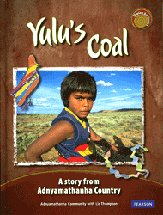Yulu's coal : a story from Adnyamathanha country by the Adnyamathanha community with Liz Thompson

Sharing our stories (series). Pearson Australia, 2011. ISBN
978 1 4425 4690 5.
(Ages 8+) Recommended. Aboriginal folklore. Yulu's coal, a story of
how the coal came to be at Leigh Creek in South Australia's far
north, is a story told over and over again by members of the
Adnyamathanha community in explaining their heritage to their
children.
The story tells of a ceremony at Wilpena Pound in the Flinders
Ranges, where all the community was waiting for Yulu the Kingfisher
Man to begin the ceremony. When he failed to appear, Wala the Wild
Turkey Man was asked instead. But Yulu did not think that Wala could
do this and lit a fire letting people know he was on his way.But two
serpents also saw the smoke signals and came down to where Copley is
today, curling around themselves forming the mountains now seen
there. Arriving at the ceremony ground, the serpents made a lot of
dust, and then ate many of the people, becoming so ill they needed
to rest, and so formed Wilpena Pound. Yulu and Wala then formed the
ochre pits near Copley and the coal now found at Leigh Creek.
The story itself tells people how the Flinders Ranges came to be and
tells much about sites found in the mountains, Copley, Chamber's
Gorge, Leigh Creek, Wilpena Pound, as well as giving much of the
cultural detail about the Adnyamathnha people. It is a
marvellous story, and is told by Noel Wilton, and illustrated by
children from Leigh Creek Area School. At the end of the book the
story is told in Adnyamathanha language and details are given about
the elders and the children in this community. I appreciated the
double page spread at the beginning introducing the Adnyamthanha
community, detailing just where the people live, and the brief but
very useful index.
All of the books in this series are similar, taking a story from one
of the Aboriginal groups in Australia, having an elder tell the
story, with children illustrating it, then adding much information
about the community, the elders and the children. Bright, inviting
illustrations round off a visually exciting range of books, sure to
add much to the teaching of Aboriginal Dreaming stories in the
classroom. But much more can be edduced from reading this with a
class. The elders' stories give an insight into our shared history
and what has happened to many Aboriginal people in the past, making
these books an ideal springboard for class discussions not only
about Dreaming stories but also the Stolen generation,
Reconciliation and the Apology. For more about this fine series, go
to this website.
Fran Knight